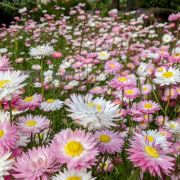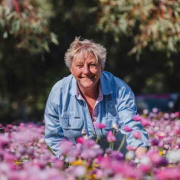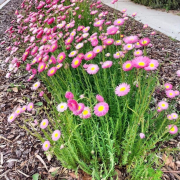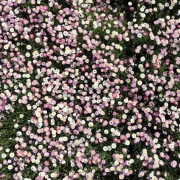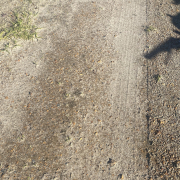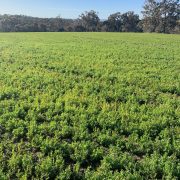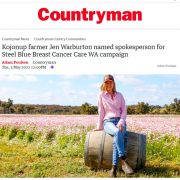What Sabrina Haan says …
To successfully grow Everlastings;
‘First clear area from weeds and control snails. Everlastings can’t compete and pests can wipe out display in a few nights. In order to get better disperal of seed, mix it with sharp sand before spreading.
Lightly cover seed with soil or rake. Either tread seed or roll seed into soil. Water gently. Some gardeners cordon off an area until germination has occurred so early germinated seedlings are not trampled.’
Everlastings are self-seeding annuals and will reseed for years to come. They are drought and frost hardy and will flower much better if fertiliser is applied after germination.’
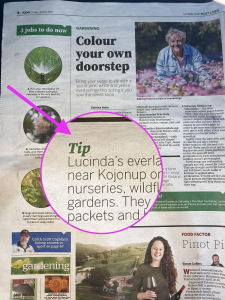
Tip #7 Mulch
Everlastings, like all plants, would also prefer protection from various harsh weather events, thus appreciate some pea hay, or mulch. Everlastings should either be planted on top of the soil surface, or gently raked in, but not buried. Mulch can then be placed very lightly on top of the Everlastings, being very careful not to smother them so they do not receive any light. It might also be an idea to throw them on top of the mulch, being aware that contact with soil is necessary for growth. You may then like to gently rake over the mulch, or water them in, so the everlasting seed falls through the mulch for seed – soil contact.
The type of mulch used is not critical as the main purpose is for protection against harsh elements, and Everlastings are quite tolerant to most soil properties, such as alkalinity or acidity.
Mulch is also useful for keeping the Everlastings where you sowed them. As much as an everlasting seed has a ‘tentacle-like’ seed covering to hold them to the ground, a very strong wind may carry them away without the stability of the mulch.
Tip #6. How thick should I plant?
It is recommended to plant at the rate of 1 g/ 1 m². This allows for perfect plant competition, shading, access to nutrition and water, and the density for the visual appearance of this site. If sowing a pot plant, just a pinch is enough, as too many seeds may dehydrate the pot plant causing moisture stress during a hot day.
Following a crop of Everlastings, the seed will fall to the ground of course, and the following year produce a very thick stand of flowers. This will remain for several years, and then dissipate from the influence either ants taking the seed away, wind blowing the seed away, or the allelopathic effect of the toxicity in the soil. For this reason, the Everlasting plant is often termed the ‘seven-year’ daisy. Sometimes it says “I have given you seven years of joy… I don’t want to grow here any more!” In this situation, renovate the soil… add fertiliser, use a rotary hoe, change the soil situation and try again!
TIP #5 Everlastings like a crumby soil!
A soil that is not compacted is friable (crumbly) and is the main reason for productive Everlasting growth and establishment. Friable soils have better aeration, allowing the roots to explore to access nutrients and moisture freely.
If your Everlastings are short and stunted, soil compaction may be an issue. To facilitate this problem, you may like to;
– till the soil with a shovel or rotary hoe
– apply gypsum
– add organic matter or mulch such as pea hay
– reduce traffic over the garden
– grow a deep-rooted plant for a year or over the summer break
Soil compaction generally applies more to clay-based soils, thus the reason everlastings are suited more to sandy/loamy soils.
If your only option for growing Everlastings is clay, try the amelioration methods above!
TIP #4 Everlastings and Fertiliser
Soil nutrition is responsible for Everlastings that look full, tall and bright. Soil nutrition is also responsible for wheat crops that look healthy and yield well. The formula is the same, they require potassium and nitrogen and a small amount of phosphorus to grow their best. Most native plants love potassium and nitrogen, so these are two elements you need. It is best to plant your Everlastings into your well-prepared soil. Plant your seed with a small amount of fertiliser, and calculate the correct amount, as too much can lead to fertiliser toxicity. Dig the fertiliser into the top 5 cm of the soil for vigorous germination and to get the best start for the crop. At about the six-week stage after planting, Everlastings will grow vigorously, requiring a top-up in nutrition. It is an excellent time to add some nitrogen at this point. This will ensure a good display in the spring of lovely tall, plump flowers with bright blooms. The nitrogen should be in Urea or a form from your Nursery or Garden Centre. Please don’t put it on too late; otherwise, it won’t add to the everlasting plant at all.
Tip #3 Time of Sowing
Everlastings can be sown at any time of year if you have a water supply. It is not recommended, however, to plant during the hot summer months as any germinating plant will struggle. It is best to plant during a regular growing season from April-May to August. If you plant in Feb-March and supply optimal nutrition, there is a chance the plants may become top-heavy and fall over with the weight of the flowerhead. If you sow after March-April, plants will be more able to hold their weight, as there is not enough growing season time for them to grow too tall. Alternatively, if you plant in September, the plant has to grow very quickly to flower at the normal time in spring. The later you sow, the shorter they will grow. Late plantings are best for sowing pot plants because often you do not want them to become too ‘leggy’, producing more plant than flowers.
Additionally, the later into the growing season they are seeded, the longer they will take to germinate and come out of the ground. This is particularly true for winter planting because the soil is colder and less conducive for a seed to become active. Sowing in the warmer autumn months, a seed can become a seedling in about two days! In the cold of winter, this can extend to 10-14 days. They will all come up eventually… be patient!! Of course, Australia is a vast land with different climates, and the time of sowing should be altered to be conducive for seeding an annual temperate plant. Frost will not hinder Everlastings, so this is something you do not need to take into consideration when determining sowing times.
Read The Full Article
Countryman – Kojonup farmer Jen Warburton named spokesperson forSteel Blue Breast Cancer Care WA campaign

A much-loved WA farmer and breast cancer survivor has become the face of a majorfundraising campaign organised by one of Australia’s biggest safety boot manufacturers.
Jen Warburton, of Kojonup, was this week named the spokesperson for Steel Blue’s BreastCancer Care WA campaign, which launched Monday.

